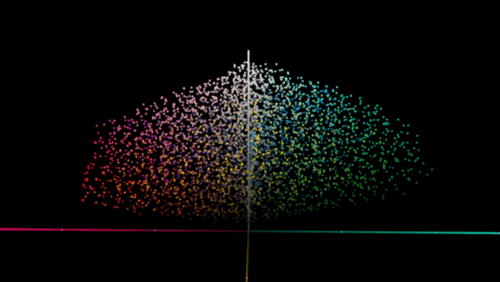Specification
- Spectral range: 380-730 nm
- Spectral resolution: 10 nm
- Supported M-conditions: M2, M1, M0
- The instrument used for measurement: X-Rite i1Pro 3
- M-2 is set as the dominant M-condition - learn more about why
- The coding convention uses M2 data to calculate Lab coordinates.
- All samples are printed on the substrate that contains a medium amount of OBAs.
Default Color Specification
ChromaSpot is designed for the print industry and has a D50/2° color specification. As a spectral library, it can calculate color coordinates for any lighting condition, including standard illuminants and custom lighting conditions. Observers can also be adapted to specific requirements. A 10° Observer is typically selected for automotive or interior design. For sample coding purposes, D50/2° is used.
Illuminants and Lighting Library.
The current list contains common standards. ChromaSpot will soon support a Lighting Library covering several hundred lights. Lighting Library is captured using 5 nm resolution and a wide spectral range.
Statistics (homogeneity) |
||||||||||||||||||
|
Spatial distribution of all ChromaSpot samples.
|
The minimal distance between any two samples in the ChromaSpot library is at least 1.5 ∆E2000. The following table reports statistics for the distance to the first, second, and third closest samples.
|
|||||||||||||||||
|
No two samples are closer than 1.5 and not farther than 4.4 ∆E, and the average distance is 2.6∆E.
|
||||||||||||||||||
Subsets
There are three pre-made color sets available, and if you choose colors for your sketchpad, you can export only the ones you've selected.
This option is especially recommended for specific projects and can be great as color swatches.
|
Full Contains 4139 samples |
Essential Contains 1700 samples |
Basic Contains 400 samples |
Scratchpad (custom) Contains selected samples |
The subsets were created for practical reasons, such as to make browsing through swatches easier.
If you selected a color from the "Basic" subset and want to find all similar swatches, paste its code into the "Search" field and you'll find them.
Neural Samples
There are 36 neutral samples (code starts with N.) selected from an extensive collection in a way where the distance between them is in a tight range of 1.9 — 2.0 ∆E. Please remember that the ∆E 2000 formula is not linear, and the distance between more samples is not a simple sum of individual deltas; however, it provides a grey ramp that is perceived as linear. The "Basic" subset limits the number of neutral samples to 25% (9 samples), and the "Essential" subset covers 18 patches (50%) and still offers visually near-identical steps.
To see all Neutrals, go to Browser, select "Chroma" view, and click on the center grey point. By choosing the subset, the list will be shortened. Neutral grays are tightened to D50/2°. By selecting different Illuminants, we can observe the impact of the light on the color of the sample.
Ranges
This additional feature allows you to limit the number of samples by eliminating all samples outside the gamut of one or more printing devices or color spaces renderable on given devices. The prediction is calculated using color management technology and based on ICC profiles, both device and named-color profiles.
If the designer knows the limitations of all manufacturing processes, he can optimize pallets used for the product to printable samples with slight deviations. More and more printing devices are using ECG technology, which is an extension of traditional CMYK> This trend is observed not only in Digital and Large Formats but also due to the economic reasons for Litho and Flexo presses. Managing ink inventory reduces the cost of recycling unused inks and reduces all logistic tasks. This trend will grow, changing the balance between custom and process inks.
ChromaSpot offers a list of common color spaces, but any custom ICC Profile can soon be used.
Missing sample?
It is possible to add any potentially missed samples. There are some rules for doing that. A sample has to be measured using an iX-Rite 1Pro3 instrument on a dedicated account. Statistics for the new sample have to be in the expected range of 1.5 - 4.4 ∆E to existing samples. An unprinted substrate sample should be added to analyze the OBA index. Library updates are periodical—a new sample will be published after approval.
